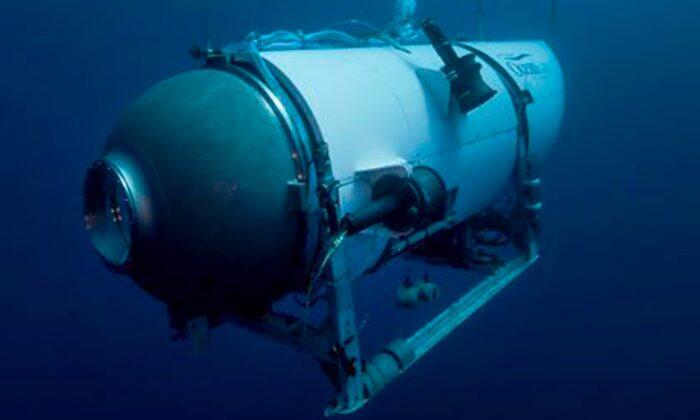A whistleblower from the company whose submersible vessel went missing this week during an undersea expedition to the Titanic had raised safety concerns ahead of the craft’s maiden voyage and was later fired.
David Lochridge once served as the director of marine operations at OceanGate, the firm whose “Titan” submersible went missing on June 18 during a deep dive to the wreckage of the Titanic.
During a meeting in Washington to discuss the handover of the Titan from OceanGate’s engineering department to Lochridge’s operations unit, issues of quality control were raised with the submersible as there were “evident flaws throughout the build process,” per the complaint.
Lochridge was asked by OceanGate executives to carry out a quality inspection on the experimental craft, although the lawsuit states that he was stonewalled when requesting key documentation while his verbal concerns over safety and quality control issues were ignored.

He issued his inspection report on Jan. 18, 2018, in which he identified “numerous issues that posed serious safety concerns” while offering recommendations for corrective action.
“Now is the time to properly address items that may pose a safety risk to personnel. Verbal communication of the key items I have addressed in my attached document have been dismissed on several occasions, so I feel now I must make this report so there is an official record in place,” Lochridge wrote in the preamble to the report, per the filing.
One of the safety concerns flagged in the report was that “visible flaws” in the carbon fiber used in the hull of the submersible could expand into bigger tears under “pressure cycling,” or changes in pressure as the craft descended to extreme ocean depths.
Nondestructive Testing Concerns
The whistleblower’s biggest concern, according to the lawsuit, was that the hull of the Titan hadn’t been subjected to nondestructive testing.“Lochridge was repeatedly told that no scan of the hull or Bond Line could be done to check for delaminations, porosity and voids of sufficient adhesion of the glue being used due to the thickness of the hull,” the complaint reads.
Instead of nondestructive testing methods, OceanGate would instead rely solely on an acoustic monitoring system that was meant to detect the start of a hull breakdown when the Titan was about to fail.
OceanGate has claimed that its in-house developed acoustic monitoring system provides an “unparalleled” safety feature that checks the integrity of the craft’s hull during every dive.
More Details
Citing “prevalent” flaws in a previously tested 1/3-scale model and “visible” flaws in the carbon fiber samples for the craft, Lochridge repeatedly stressed the potential danger to passengers of the Titan as it reached extreme depths.“The constant pressure cycling weakens existing flaws resulting in large tears of the carbon,” the complaint reads. “Non-destructive testing was critical to detect such potentially existing flaws in order to ensure a solid and safe product for the safety of the passengers and crew.”
A day after Lochridge submitted his inspection report detailing his concerns, he was called into a meeting with OceanGate executives, at which he discovered why he was denied access to technical documentation from engineers about the submersible’s viewport.
“The viewport at the forward of the submersible was only built to a certified pressure of 1,300 meters, although OceanGate intended to take passengers down to depths of 4,000 meters,” the complaint reads.
Lochridge learned that the manufacturer of the viewport would only certify it to a depth of 1,300 meters (4,265 feet) because of its experimental nature and that OceanGate refused to pay for the manufacturer to build a viewport that would meet the extreme depth to which the Titan was meant to descend.
The wreckage of the Titanic lies on the floor of the Atlantic Ocean at a depth of about 12,500 feet (3,800 meters).
Lochridge also raised concerns about dangerous flammable materials that were being used in the craft and said during the meeting that he wouldn’t authorize any manned tests of the Titan unless the hull was subjected to a nondestructive testing scan.
He was fired at the end of the meeting and escorted out of the building.
The company examined his work laptop and “determined that its hard drive had been scrubbed of all company and other material, suggesting that Lochridge had desired to be fired and had prepared his report and responded to OceanGate during the meeting so as to precipitate his termination,” according to the complaint.
Lochridge later counter-sued for wrongful dismissal.
The Epoch Times has been unable to reach Lochridge for comment.
The 21-foot submersible was reported missing on June 18 about 435 miles south of St. John’s, Newfoundland, Canada, after it failed to return to the Polar Prince, the Canadian research ship from which it was launched.
As of press time, the submersible remains unaccounted for and a rescue operation is underway. It has been reported that Rush, French diver Paul-Henri Nargeolet, British billionaire Hamish Harding, and Pakistani businessman Shahzada Dawood and his son were on board.





